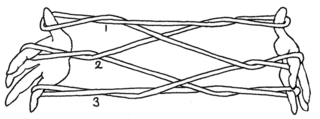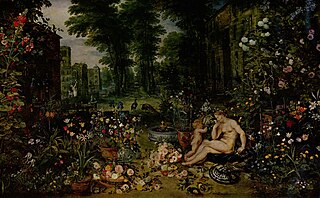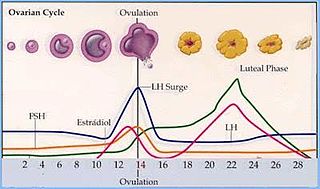Related Research Articles
A pheromone is a secreted or excreted chemical factor that triggers a social response in members of the same species. Pheromones are chemicals capable of acting like hormones outside the body of the secreting individual, to affect the behavior of the receiving individuals. There are alarm pheromones, food trail pheromones, sex pheromones, and many others that affect behavior or physiology. Pheromones are used by many organisms, from basic unicellular prokaryotes to complex multicellular eukaryotes. Their use among insects has been particularly well documented. In addition, some vertebrates, plants and ciliates communicate by using pheromones. The ecological functions and evolution of pheromones are a major topic of research in the field of chemical ecology.

The flehmen response, also called the flehmen position, flehmen reaction, flehmen grimace, flehming, or flehmening, is a behavior in which an animal curls back its upper lip exposing its front teeth, inhales with the nostrils usually closed, and then often holds this position for several seconds. It may be performed over a sight or substance of particular interest to the animal, or may be performed with the neck stretched and the head held high in the air.

The house mouse is a small mammal of the order Rodentia, characteristically having a pointed snout, large rounded ears, and a long and almost hairless tail. It is one of the most abundant species of the genus Mus. Although a wild animal, the house mouse has benefited significantly from associating with human habitation to the point that truly wild populations are significantly less common than the semi-tame populations near human activity.

Menstrual synchrony, also called the McClintock effect, or the Wellesley effect, is a contested process whereby women who begin living together in close proximity would experience their menstrual cycle onsets becoming more synchronized together in time than when previously living apart. "For example, the distribution of onsets of seven female lifeguards was scattered at the beginning of the summer, but after 3 months spent together, the onset of all seven cycles fell within a 4-day period."
The estrous cycle is a set of recurring physiological changes induced by reproductive hormones in females of mammalian subclass Theria. Estrous cycles start after sexual maturity in females and are interrupted by anestrous phases, otherwise known as "rest" phases, or by pregnancies. Typically, estrous cycles repeat until death. These cycles are widely variable in duration and frequency depending on the species. Some animals may display bloody vaginal discharge, often mistaken for menstruation. Many mammals used in commercial agriculture, such as cattle and sheep, may have their estrous cycles artificially controlled with hormonal medications for optimum productivity. The male equivalent, seen primarily in ruminants, is called rut.
The Lee–Boot effect is a phenomenon concerning the suppression or prolongation of oestrous cycles of mature female mice, when females are housed in groups and isolated from males. It is caused by the effects of an estrogen-dependent pheromone, possibly 2,5-dimethylpyrazine, which is released via the urine and acts on the vomeronasal organ of recipients. This pheromone lowers the concentration of luteinizing hormone and elevates prolactin levels, synchronising or stopping the recipient's cycle. This effect goes some way to explain why spontaneous pseudopregnancy can occur in mice. The same response is invoked from isolated females when brought into contact with urine-soaked bedding from other females' cages. The adrenal glands are required for production of the urine pheromone which is responsible for this effect.

Reproductive suppression is the prevention or inhibition of reproduction in otherwise healthy adult individuals. It occurs in birds, mammals, and social insects. It is sometimes accompanied by cooperative breeding. It is maintained by behavioral mechanisms such as aggression, and physiological mechanisms such as pheromone signalling. In evolutionary terms, it may be explained by the theory of inclusive fitness.
The Vandenbergh effect is a phenomenon reported by J.G. Vandenbergh et al. in 1975, in which an early induction of the first estrous cycle in prepubertal female mice occurs as a result of exposure to the pheromone-laden urine of a sexually mature (dominant) male mouse.

An odor or odour is caused by one or more volatilized chemical compounds that are generally found in low concentrations that humans and many animals can perceive via their sense of smell. An odor is also called a "smell" or a "scent", which can refer to either an unpleasant or a pleasant odor.

Major urinary proteins (Mups), also known as α2u-globulins, are a subfamily of proteins found in abundance in the urine and other secretions of many animals. Mups provide a small range of identifying information about the donor animal, when detected by the vomeronasal organ of the receiving animal. They belong to a larger family of proteins known as lipocalins. Mups are encoded by a cluster of genes, located adjacent to each other on a single stretch of DNA, that varies greatly in number between species: from at least 21 functional genes in mice to none in humans. Mup proteins form a characteristic glove shape, encompassing a ligand-binding pocket that accommodates specific small organic chemicals.
The Bruce effect, or pregnancy block, is the tendency for female rodents to terminate their pregnancies following exposure to the scent of an unfamiliar male. The effect was first noted in 1959 by Hilda M. Bruce, and has primarily been studied in laboratory mice. In mice, pregnancy can only be terminated prior to embryo implantation, but other species will interrupt even a late-term pregnancy.
Hilda Margaret Bruce was a British zoologist, best known for her discovery of the Bruce effect, a pheromonal behaviour observed in many rodent species. Her work on the control of fertility earned her the Oliver Bird Medal.
Odour is sensory stimulation of the olfactory membrane of the nose by a group of molecules. Certain body odours are connected to human sexual attraction. Humans can make use of body odour subconsciously to identify whether a potential mate will pass on favourable traits to their offspring. Body odour may provide significant cues about the genetic quality, health and reproductive success of a potential mate.
Menstruation is the shedding of the uterine lining (endometrium). It occurs on a regular basis in uninseminated sexually reproductive-age females of certain mammal species.

2-sec-Butyl-4,5-dihydrothiazole (also known as SBT) is a thiazoline compound with the molecular formula C7H13NS. A volatile pheromone found in rodents such as mice and rats, SBT is excreted in the urine and promotes aggression amongst males while inducing synchronized estrus in females.

Most mammals are viviparous, giving birth to live young. However, the five species of monotreme, the platypuses and the echidnas, lay eggs. The monotremes have a sex determination system different from that of most other mammals. In particular, the sex chromosomes of a platypus are more like those of a chicken than those of a therian mammal.

The Great Pheromone Myth is a book on pheromones and their application to chemosensation in mammals by Richard L. Doty, director of the University of Pennsylvania's Smell and Taste Center in Philadelphia. Doty argues that the concept of pheromone introduced by Karlson and Lüscher is too simple for mammalian chemonsensory systems, failing to take into account learning and the context-dependence of chemosensation. In this book, he is especially critical of human pheromones, arguing that not only are there no definitive studies finding human pheromones, but that humans lack a functional vomeronasal organ to detect pheromones. Its publication received coverage in the news media, especially concerning its arguments that human pheromones do not exist.

Induced ovulation is when a female animal ovulates due to an externally-derived stimulus during or before mating, but not cyclically or spontaneously. Ovulation can be induced by sperm or pheromones or by mechanical stimulation during copulation.

In zoology, copulation is animal sexual behavior in which a male introduces sperm into the female's body, especially directly into her reproductive tract. This is an aspect of mating. Many animals that live in water use external fertilization, whereas internal fertilization may have developed from a need to maintain gametes in a liquid medium in the Late Ordovician epoch. Internal fertilization with many vertebrates occurs via cloacal copulation, known as cloacal kiss, while most mammals copulate vaginally, and many basal vertebrates reproduce sexually with external fertilization.
The Hoover-Drickamer effect occurs when adult female mice are exposed to the urine of pregnant and lactating adult female mice, resulting in a longer than typical oestrus period. The effect was first noted by J. E. Hoover and L. C. Drickamer in their 1979 study wherein they randomly assigned adult female mice to one of four treatment conditions: a control group where the subjects were exposed to water, a group that was exposed to the urine of pregnant mice, a group that was exposed to the urine of lactating mice and a group that was exposed to the urine of a singly caged female mouse.
References
- ↑ Carlson, Neil R. (2013). Physiology of behavior (11th ed.). Boston: Pearson. p. 335. ISBN 978-0205239399.
- 1 2 Ochiogu, Izuchukwu S., Chike F. Oguejiofor, and Ambrose N. Nwagbo. "Males' Non-Enhancement of Bruce and Whitten Effects in Female Mice – Mus Musculus." Animal Research International 6 (2009): 1077-081.
- 1 2 Jemilio, Bozena, Scott Harvey, and Milos Novotny. "Promotion of the Whitten Effect in Female Mice by Synthetic Analogs of Male Urinary Constituents." Proceedings of the National Academy of Sciences of the United States of America 83 (1986): 4576-579.
- ↑ Gangrade, B.K., and C.J. Dominik. "Studies of the Male-Originating Pheromones Involved in the Whitten Effect and Bruce Effect in Mice." Biology of Reproduction 31 (1984): 89-96.
- 1 2 Ma, Weidong, Zhongshan Miao, and Milos V. Novotny. "Introduction of Estrus in Grouped Female Mice (Mus Domesticus) by Synthetic Analogs of Preputial Gland Constituents." Chem. Senses 24 (1999): 289-93.